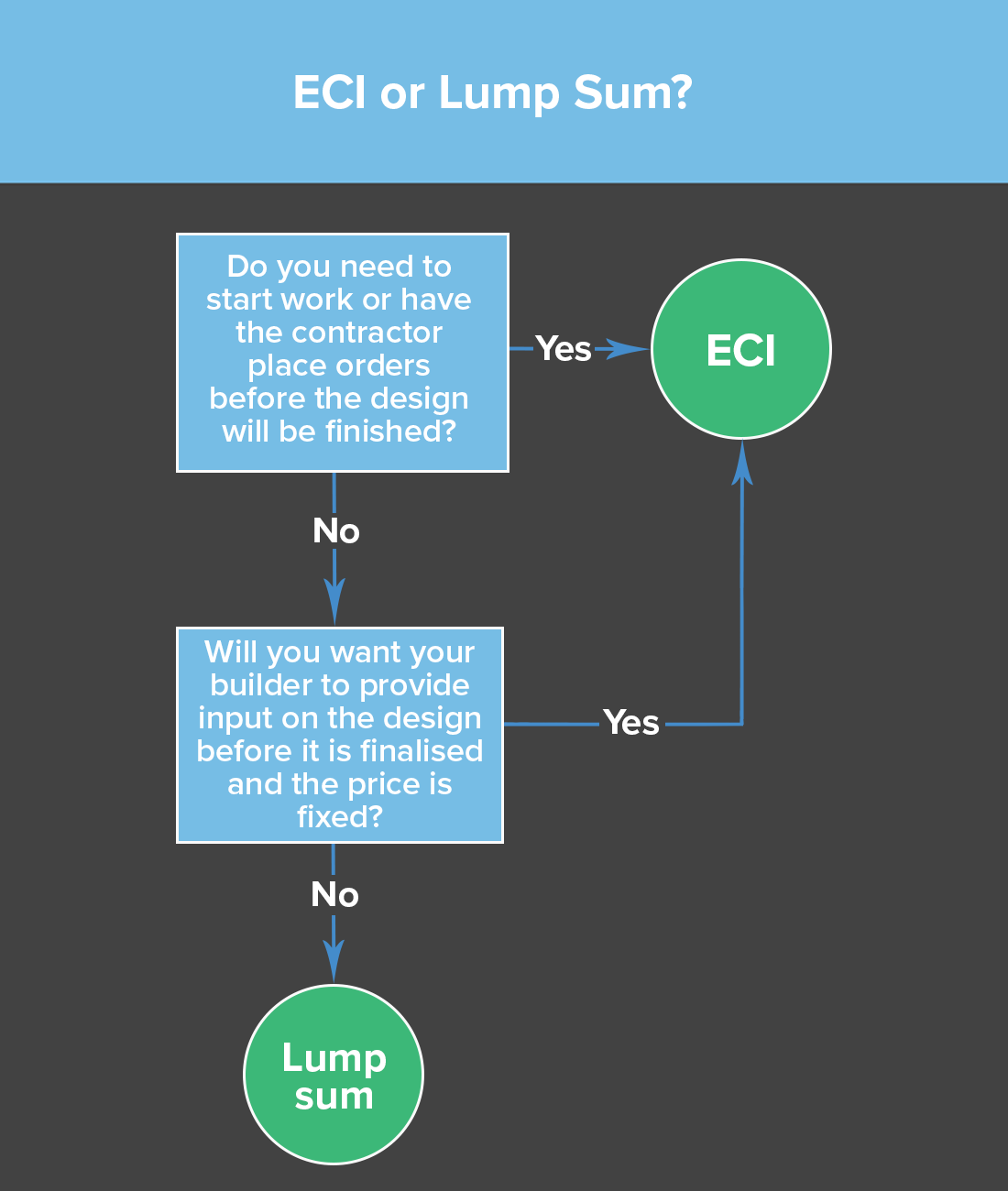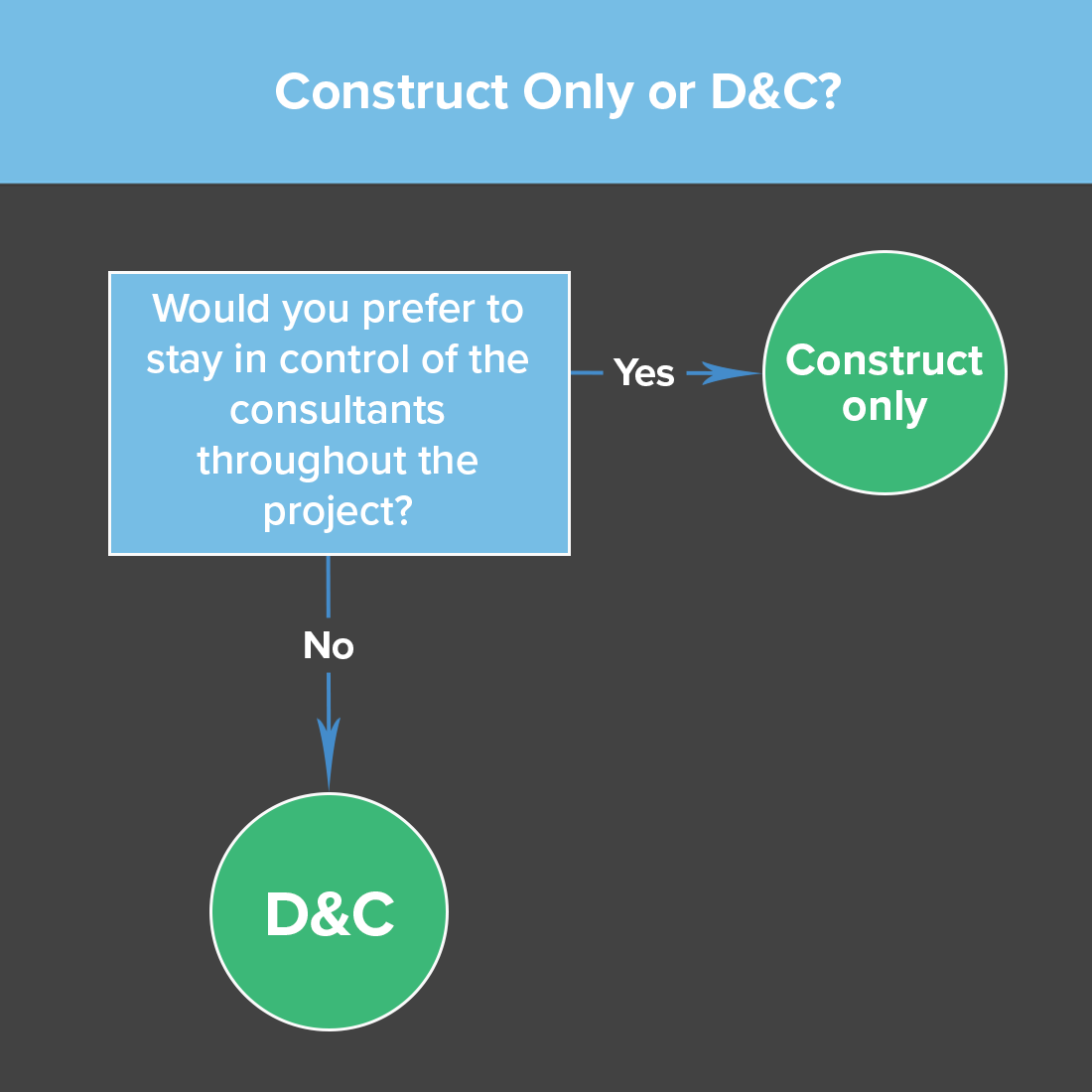This article explains the different types of construction contract, and explains how to choose the right type of contract for your next project. Although the same general principles should apply to residential projects, this article is focused on commercial construction contracts.
3 key questions
Although there are a number of different contracts to choose from, and a number of different considerations that need to be taken into account, most of the time the issue boils down to three questions:
1. Do you need to start work or have the contractor place orders before the design will be finished?
2. Do you want your builder to provide input on the design before it is finalised and the price is fixed?
3. Would you prefer to retain control of the consultants throughout the project?
The answers to these questions will determine the type of contract you should consider. Your main options are:
- Lump Sum Construct Only (eg AS 4000, AS 2124);
- Lump Sum Design & Construct (‘D&C’) (eg AS 4902, AS 4300);
- Early Contractor Involvement Construct Only (eg AS 4916, modified AS 4000 or modified AS 2124); and
- Early Contractor Involvement Design & Construct (eg AS 4916, modified AS 4902 or modified AS 4300).
Although there are a variety of other forms of contract, the Australian Standard forms of contract mentioned above tend to be the most commonly used. You can read more about AS 4000 here. You can read more about Early Contractor Involvement (ECI) contracting here. You can read about the AS 4916 construction management contract here.

Lump sum versus ECI
A lump sum contract is a contract where the contractor is engaged to perform an agreed scope of works for an agreed lump sum price.
In contrast, Early Contractor Involvement or ECI contracts are typically ‘cost plus’ arrangements. That is, the contractor is paid a fee for its preliminaries, profit and overheads (referred to as ‘the cost’), ‘plus’ an amount for the contractor’s third party costs (mainly subcontractor and consultant costs) for carrying out the project.
Lump sum contracts tend to be most effective where the design of the works is in sufficient detail to enable a contractor to propose a lump sum price. As a general rule, the more uncertainty there is in the scope, the more risk there will be for the contractor, and the higher their price is likely to be.
Do you need to start work or have the contractor place orders before the design will be finished and the price is fixed?
If the answer to this question is ‘yes’, you may not have much choice but to opt for an ECI contract.
The key difference between lump sum and ECI contracting is that, at the time you enter into the contract under an ECI contract, you are likely to have less certainty around the final scope and price of the works.
Three of the main advantages of an ECI contract are:
- ECI contracts are better suited to fast-track projects;
- ECI contracting is more flexible than lump sum contracting; and
- ECI contracts will include a competitive tender process for the trade works, which will typically be conducted on an open book basis.
You can read more about ECI contracting here.
If the design of your project is mostly complete, and there are only a handful of design elements outstanding, a lump sum project could still be used with provisional sums allocated to the outstanding design elements. You can read more about provisional sums here.
Will you want your builder to provide input on the design before it is finalised?
Where the work is relatively straightforward, and assuming time is not an issue, conventional lump sum contracting is usually preferred. This is because:
- a lump sum tender process ensures the principal will have the benefit of competitive pricing; and
- a lump sum contract will give the principal more certainty around the final cost of the project at an early stage.
However there are situations where a principal can benefit from input from the builder before the design of the works has been finalised. The most common situations are where the project involves complicated design or construction elements, or where the principal wants input from a builder to help manage its budget.
As part of their obligations under an ECI contact, contractors are normally expected to provide assistance in the following areas:
- Buildability – identifying any challenges that may arise during construction of the works, and working with the design team to find solutions to avoid or overcome them;
- Value Engineering – identifying potential changes to the design where savings may be possible, if there are budgetary pressures;
- Design management – coordinating the design team, to ensure the design is finalised in accordance with the program and within the principal’s budget.

Would you prefer to retain control of the consultants throughout the project?
There are two competing schools of thought.
On the one hand, some principals prefer to retain control of the consultants to ensure that they remain in complete control of the design. This approach is intended to ensure that there are no design compromises during the course of the project, and to also ensure that the contract is held in check.
A consultant who is engaged and paid by the principal may think and behave differently, and may receive different instructions, when compared to a consultant engaged and paid by the contractor.
On the other hand, some principals prefer for the contractor to engage the design team (whether directly or by novation), so that if a problem emerges, the principal will have single point of recourse in the contractor.
If a defect arises in circumstances where the contractor has engaged the consultants, there is no risk of the contractor and the consultants ‘pointing the finger’ at each other. Responsibility will lie solely with the contractor.
Next steps
Once you have worked out what contracting method you would like to use, the next step is to design the contract. Not only are there different contracts to choose from, there will be different options within these contracts.
For example, even for a basic lump sum construct only contract, there are numerous forms of contract to choose from (including AS 4000, AS 2124), and principals will typically seek to make amendments. (For example, you can read about common amendments to AS 4000 here and common amendments to AS 2124 here.) Contractors may also seek changes, including by limiting their liability, excluding consequential loss or introducing a rise and fall clause.
It is at this point that a session with an experienced construction lawyer may help to refine your thinking. If you would like to speak with us about your options, you can contact us here.







